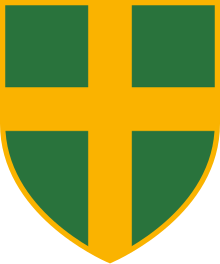 | Review waiting, please be patient.
This may take 5 weeks or more, since drafts are reviewed in no specific order. There are 975 pending submissions waiting for review.
Where to get help
How to improve a draft
You can also browse Wikipedia:Featured articles and Wikipedia:Good articles to find examples of Wikipedia's best writing on topics similar to your proposed article. Improving your odds of a speedy review To improve your odds of a faster review, tag your draft with relevant WikiProject tags using the button below. This will let reviewers know a new draft has been submitted in their area of interest. For instance, if you wrote about a female astronomer, you would want to add the Biography, Astronomy, and Women scientists tags. Editor resources
Reviewer tools
|
| Coat of arms of Pula | |
|---|---|
 | |
| Versions | |
 Ceremonial version | |
 Version without the gold outline | |
 The banner of arms, which serves as the flag of the city | |
| Armiger | Pula |
| Adopted | 1846 12 November 1993 |
| Shield | Vert a Latin cross Or throughout. |
| Earlier version(s) |    |
The coat of arms of Pula depicts a yellow Latin cross on top of a green background. It also has a ceremonial version consisting of the same design on a special Renaissance escutcheon with a lily shape on the top.[1]
History
editPula's first recorded arms were the arms of the Pola family, which was "Barry gules and argent a bordure chequy of the same". After the Pola family got deposed in 1331, no official emblem or coat of arms was adopted, with the exception of the Venetian lion until the early 1800s. In October 1807, an oval shield with a cross stretching to the borders of the shield was adopted during French administration, but the exact colours used are unknown. The coat of arms that uses the green-gold colour scheme was finally confirmed in 1846 with a mural crown crest surrounded by the initials C.P. for Citta di Pola (transl. City of Pula). A 1904 book of coats of arms of Austria-Hungary by Hugo Gerard Ströhl portrays it with a Volkskrone crest. After the First World War, Austria-Hungary dissolved and Pula was ceded to Italy. During Italian administration, the coat of arms had a civic crown, oak and laurel branches, along with a blue ribbon. After the Second World War, Yugoslavia's monarchy was abolished and replaced by a new communist government, of which Pula was ceded to in 1947. Pula stopped using the historical coat of arms and adopted a new coat of arms in c. 1959 depicting an Azure field surrounded by Argent rope with an Argent display of the Pula arena, in front of which is a cargo ship and a construction crane to its left and a star in the top right corner. A new coat of arms displaying the Pula arena and a communist red star in the top right corner was adopted in c. 1969. Once Yugoslavia collapsed, Croatia declared independence and abolished communism, Pula changed back its coat of arms to the gold cross on a green background design on 12 November 1993, which it still has today.[2]
Design
editThe coat of arms consists of a green shield with a gold cross on it. The arms of the cross stretch to the borders of the shield. The proportions of the shield are 5:6, with the arms of the cross being 1 unit wide and the horizontal arm being placed 2 units from the top border of the shield. Most of the time the coat of arms has a gold outline, but sometimes it is portrayed without the outline.[2]
References
edit- ^ "Grb i zastava | Grad Pula". www.pula.hr. Retrieved 2024-10-21.
- ^ a b "Pula (Town, Istria County, Croatia)". www.fotw.info. Retrieved 2024-10-26.